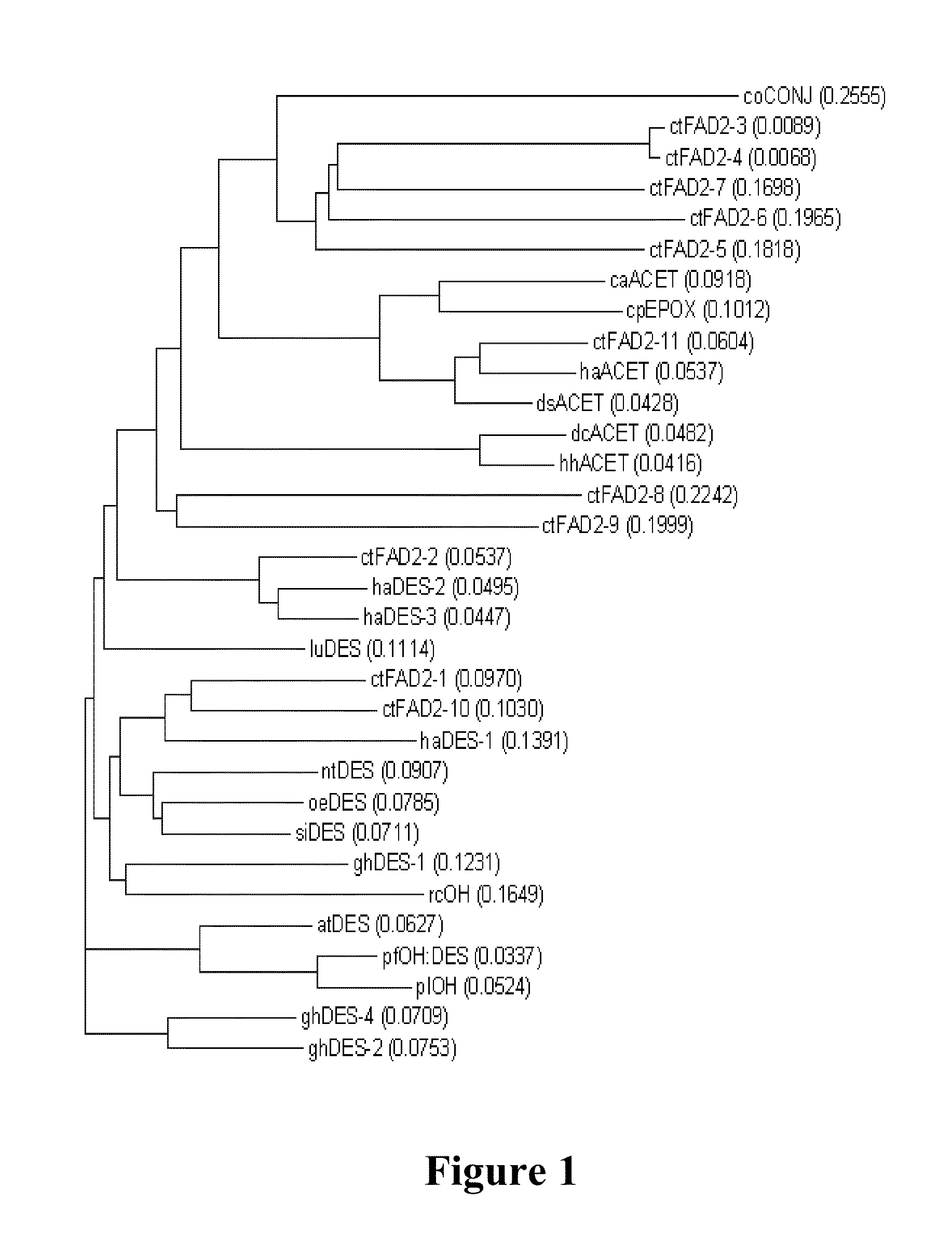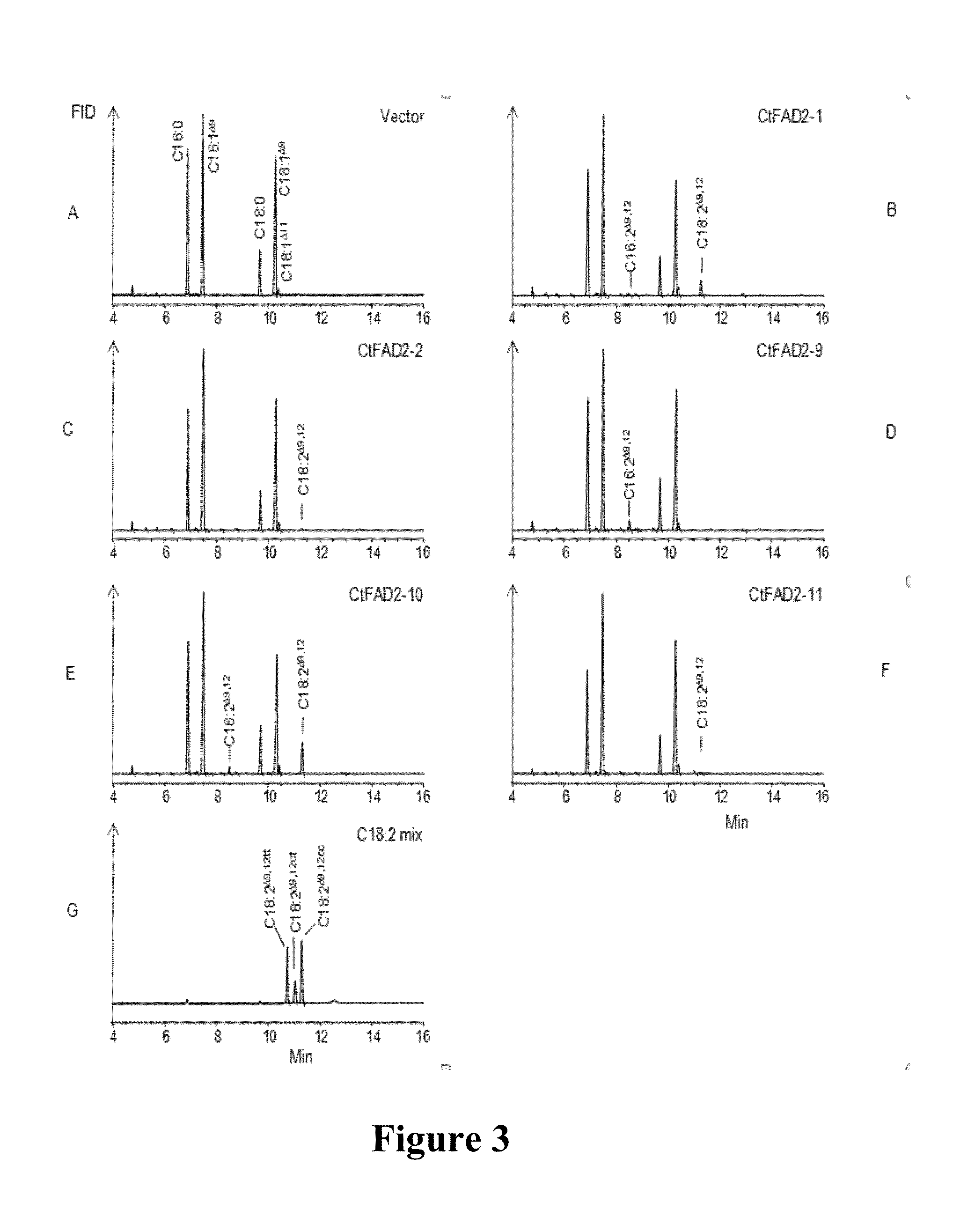High oleic acid oils
- Summary
- Abstract
- Description
- Claims
- Application Information
AI Technical Summary
Benefits of technology
Problems solved by technology
Method used
Image
Examples
example 1
General Materials and Methods
Plant Materials and Growth Conditions
[0438]Safflower plants (Carthamus tinctorius) genotypes SU, S-317, S-517, LeSaf496, CW99-OL, and Clano-OL were grown from seed in the glasshouse in a perlite and sandy loam potting mix under a day / night cycle of 16 hrs (25° C.) / 8 hrs (22° C.). The wild type variety SU, which is a high linoleic variety, was obtained from Heffernan Seeds in NSW. Seeds of PI 603208 (LeSaf496, ATC 120562) and CW 99-OL (ATC 120561) were obtained from the Australian Temperate Field Crops Collection.
[0439]Plant tissues for DNA and RNA extraction including leaves, roots, cotyledons and hypocotyls were harvested from safflower seedlings 10 days post-germination. Flowering heads were obtained at the first day of flower opening and developing embryos were harvested at three developmental stages at 7 (early), 15 (middle) and 20 (late) days post anthesis (DPA). Samples were immediately chilled in liquid nitrogen and stored at −80° C. until DNA and...
example 2
Isolation of Safflower cDNAs which are Candidates for Encoding FAD2
[0461]Total RNA extraction and cDNA Synthesis
[0462]In order to produce cDNA from safflower, total RNA was isolated from 100 mg samples of frozen safflower tissues including developing embryos, leaves, roots and hypocotyls. This was done for each tissue separately using an RNeasy® Plant total RNA kit (Qiagen, Hilden, Germany) according to the supplier's protocol. The RNA concentration in the preparations was determined with a NanoDrop™ spectrophotometer ND1000 (Thermo Fisher Scientific, Victoria, Australia) and the RNA concentrations were equalized before analysis. The quality and relative quantities of the RNA in each preparation were visualized by gel electrophoresis of samples through 1% (w / v) agarose gels containing formaldehyde. The RNA preparations were treated with RQ1 RNase-free DNase (Qiagen, Hilden, Germany) to remove contaminating genomic DNA. First-strand cDNA was synthesized from 400 ng of each DNA-free R...
example 3
Isolation of Genomic Sequences for FAD2 Candidates
Isolation of 5′UTR Introns of the Candidate CtFAD2 Genes
[0479]The intron-exon structures of FAD2 genes are conserved in many flowering plants. All FAD2 genes studied so far contain only one intron which is located at the 5′UTR, with one exception being soybean FAD2-1 for which the intron is located in the coding region immediately following the first ATG, the translational initiation codon (Liu et al., 2001; Kim et al., 2006; Mroczka et al., 2010). Intron sequence divergence could be used as a measure of evolutionary distance between taxonomically closely related species (Liu et al., 2001).
[0480]In order to isolate the DNA sequences of possible introns situated within the 5′-UTRs of the candidate CtFAD2 genes, the typical intron splice sites (AG:GT) were predicted in the 5′ UTR of each CtFAD2 cDNA sequence, and PCR primers were designed based on the flanking sequences of predicted splice sites. The primers are listed in Table 7. Geno...
PUM
| Property | Measurement | Unit |
|---|---|---|
| Weight | aaaaa | aaaaa |
| Fraction | aaaaa | aaaaa |
| Fraction | aaaaa | aaaaa |
Abstract
Description
Claims
Application Information
 Login to View More
Login to View More - R&D
- Intellectual Property
- Life Sciences
- Materials
- Tech Scout
- Unparalleled Data Quality
- Higher Quality Content
- 60% Fewer Hallucinations
Browse by: Latest US Patents, China's latest patents, Technical Efficacy Thesaurus, Application Domain, Technology Topic, Popular Technical Reports.
© 2025 PatSnap. All rights reserved.Legal|Privacy policy|Modern Slavery Act Transparency Statement|Sitemap|About US| Contact US: help@patsnap.com



